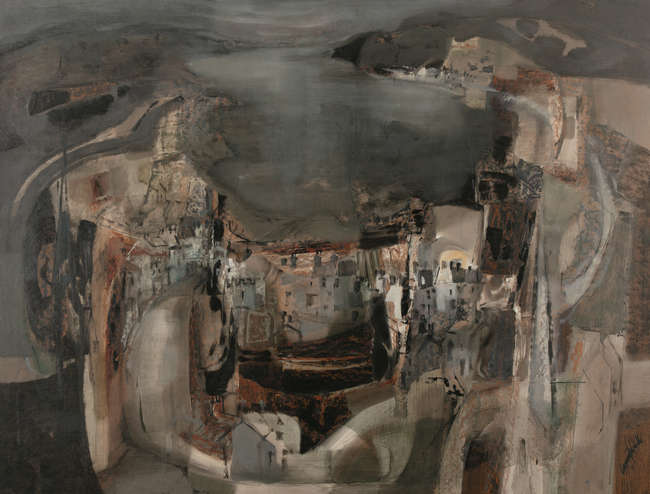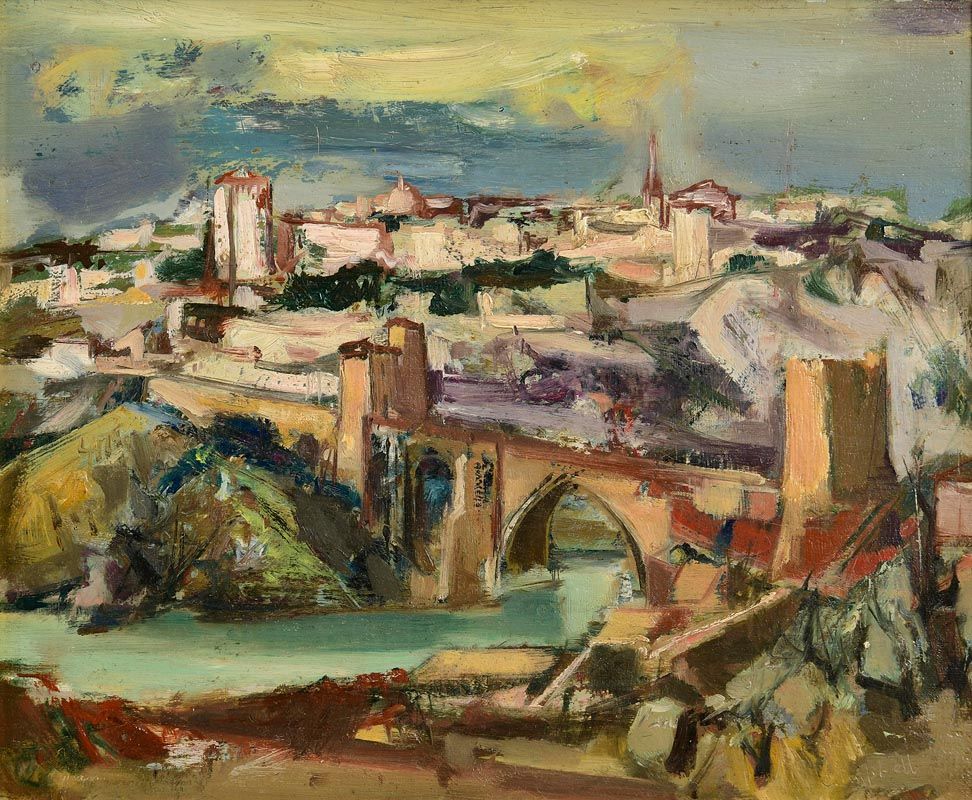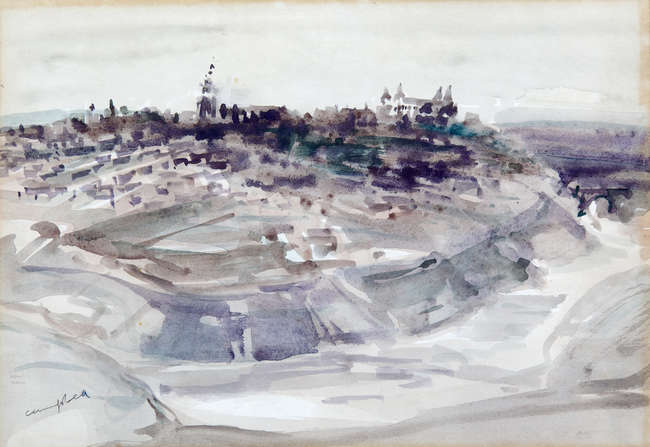George Campbell RHA (1917-1979) Toledo Oil on board, 71 x 96.5cm (28 x 38'') Signed Born in County Wicklow, George Campbell spent the latter part of his childhood in Northern Ireland. Thus, when he fully committed to painting at the age of twenty-four, it was to the artistic community of Belfast that he turned for guidance. Believing the art schools to be too rigid, Campbell learned his skills from fellow artists, developing a style imbued with the tastes of the North. Moving to Dublin in the mid-1940s, Campbell established himself near the port where he came into contact with the Spanish sailors as they moved in and out of the city. From these encounters, Campbells fascination with Spain took root and it was only a matter of time before he travelled to the country. In 1951, accompanied by his wife and artist Gerard Dillon Campbell worked his way down through Spain. Reaching the Spanish coast in the south, Campbell fell in love with Málaga and incorporated himself into the lifestyle and culture of the town. Over the next twenty years, Campbell spent his winters in Spain, escaping the cold and damp of the Irish climate. He fell in love with the colours, the music and the characters, filling his sketchbooks with the vibrancy of Spanish life. On returning to Ireland each spring, Campbell would turn these sketches into fully matured oil paintings, selling them through galleries in Dublin and London. Venturing away from the coast, Campbell made several paintings of Toledo. Located in central Spain, just south of Madrid, Toledo is imbued with history and cultural significance. For an artist who was drawn to the historical and ancient sites of Ireland, Toledo represented a Spanish equivalent. Surrounded on three sides by a river, the city dates back to Roman rule and was once the capital of the Spanish Empire. In the 16th century, Toledo was home to El Greco an artist whose work was much admired by Campbell and this must have resonated with him as he painted his cityscapes. Unlike many of his Spanish works which are bursting with bright, warm colours, this view of Toledo offers a more sombre depiction, showing the city in the quiet hours of the night. Emerging from the moody purple of the surrounding land and sky, the whitewashed walls of Toledo shine in the moonlight. The buildings are proffered forth like a ghost town on the edge of two worlds, the blurred margins slipping silently back into the night. In 1971, Campbell spoke to BBC Northern Ireland and referred to Spain of the ethereal light and the mysterious nightsÔǪ its rugged and lace shapes and textures hard wrought by thousands of years. In Toledo, we see Campbells words transformed into a physical representation. Whilst Campbell lived between Ireland and Spain, it was to Spain that his heart belonged and his connection with the country was officially recognised when, in 1978, he was made a Commander of the Order of Merito Civile. Sadly, he died the following year but Campbells love affair with both Ireland and Spain is beautifully continued through the works that he left behind. Helena Carlyle, May 2019 George Campbell RHA (1917-1979) Toledo Oil on board, 71 x 96.5cm (28 x 38'') Signed Born in County Wicklow, George Campbell spent the latter part of his childhood in Northern Ireland. Thus, when he fully committed to painting at the age of twenty-four, it was to the artistic community of Belfast that he turned for guidance. Believing the art schools to be too rigid, Campbell learned his skills from fellow artists, developing a style imbued with the tastes of the North. Moving to Dublin in the mid-1940s, Campbell established himself near the port where he came into contact with the Spanish sailors as they moved in and out of the city. From these encounters, Campbells fascination with Spain took root and it was only a matter of time before he travelled to the country. In 1951, accompanied by his wife and artist Gerard Dillon Campbell worked his way down through Spain. R
George Campbell RHA (1917-1979) Toledo Oil on board, 71 x 96.5cm (28 x 38'') Signed Born in County Wicklow, George Campbell spent the latter part of his childhood in Northern Ireland. Thus, when he fully committed to painting at the age of twenty-four, it was to the artistic community of Belfast that he turned for guidance. Believing the art schools to be too rigid, Campbell learned his skills from fellow artists, developing a style imbued with the tastes of the North. Moving to Dublin in the mid-1940s, Campbell established himself near the port where he came into contact with the Spanish sailors as they moved in and out of the city. From these encounters, Campbells fascination with Spain took root and it was only a matter of time before he travelled to the country. In 1951, accompanied by his wife and artist Gerard Dillon Campbell worked his way down through Spain. Reaching the Spanish coast in the south, Campbell fell in love with Málaga and incorporated himself into the lifestyle and culture of the town. Over the next twenty years, Campbell spent his winters in Spain, escaping the cold and damp of the Irish climate. He fell in love with the colours, the music and the characters, filling his sketchbooks with the vibrancy of Spanish life. On returning to Ireland each spring, Campbell would turn these sketches into fully matured oil paintings, selling them through galleries in Dublin and London. Venturing away from the coast, Campbell made several paintings of Toledo. Located in central Spain, just south of Madrid, Toledo is imbued with history and cultural significance. For an artist who was drawn to the historical and ancient sites of Ireland, Toledo represented a Spanish equivalent. Surrounded on three sides by a river, the city dates back to Roman rule and was once the capital of the Spanish Empire. In the 16th century, Toledo was home to El Greco an artist whose work was much admired by Campbell and this must have resonated with him as he painted his cityscapes. Unlike many of his Spanish works which are bursting with bright, warm colours, this view of Toledo offers a more sombre depiction, showing the city in the quiet hours of the night. Emerging from the moody purple of the surrounding land and sky, the whitewashed walls of Toledo shine in the moonlight. The buildings are proffered forth like a ghost town on the edge of two worlds, the blurred margins slipping silently back into the night. In 1971, Campbell spoke to BBC Northern Ireland and referred to Spain of the ethereal light and the mysterious nightsÔǪ its rugged and lace shapes and textures hard wrought by thousands of years. In Toledo, we see Campbells words transformed into a physical representation. Whilst Campbell lived between Ireland and Spain, it was to Spain that his heart belonged and his connection with the country was officially recognised when, in 1978, he was made a Commander of the Order of Merito Civile. Sadly, he died the following year but Campbells love affair with both Ireland and Spain is beautifully continued through the works that he left behind. Helena Carlyle, May 2019 George Campbell RHA (1917-1979) Toledo Oil on board, 71 x 96.5cm (28 x 38'') Signed Born in County Wicklow, George Campbell spent the latter part of his childhood in Northern Ireland. Thus, when he fully committed to painting at the age of twenty-four, it was to the artistic community of Belfast that he turned for guidance. Believing the art schools to be too rigid, Campbell learned his skills from fellow artists, developing a style imbued with the tastes of the North. Moving to Dublin in the mid-1940s, Campbell established himself near the port where he came into contact with the Spanish sailors as they moved in and out of the city. From these encounters, Campbells fascination with Spain took root and it was only a matter of time before he travelled to the country. In 1951, accompanied by his wife and artist Gerard Dillon Campbell worked his way down through Spain. R








Testen Sie LotSearch und seine Premium-Features 7 Tage - ohne Kosten!
Lassen Sie sich automatisch über neue Objekte in kommenden Auktionen benachrichtigen.
Suchauftrag anlegen